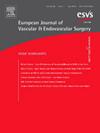使用随机森林分类算法预测单中心腹主动脉瘤选择性修复术后两年生存率。
IF 6.8
1区 医学
Q1 PERIPHERAL VASCULAR DISEASE
European Journal of Vascular and Endovascular Surgery
Pub Date : 2025-04-01
DOI:10.1016/j.ejvs.2024.11.357
引用次数: 0
摘要
目的:选择腹主动脉瘤(AAA)修复需要权衡破裂风险、术中死亡率和预期寿命。随机森林分类器(rfc)是一种强大的机器学习算法。本研究的目的是构建并验证随机森林机器学习工具,以预测选择性AAA修复后的两年生存率。方法:回顾2008年1月1日至2021年3月31日所有接受选择性开放或血管内修复的AAA患者。采用血管外科质量改进程序途径进行评估,包括心肺运动测试、增强计算机断层扫描和多学科评估。对患者进行了至少两年的随访。使用70%的数据集开发RFC,并使用30%的数据集进行验证,以预测AAA修复后至少两年的生存率。结果:共925例患者(男性836例;89名女性)行选择性AAA修补术;126例(13.6%)在头两年内死亡;11例(1.2%)死于手术期间死亡。变量重要性分析表明,无氧阈值、术前血红蛋白、最大耗氧量、体重指数、危险类别和1秒用力呼气量与用力肺活量比是模型最重要的影响因素。RFC预测术后两年生存率的敏感性和特异性分别为96.7% (95% CI 94.4 - 99%)和67.1% (95% CI 61 - 72%);总体准确率:92.6% (95% CI 88 - 95%)(阳性预测值:0.93,阴性预测值:0.80);10倍交叉验证显示接收者操作者特征曲线下面积为0.88。结论:基于现有临床数据的rfc可以成功预测AAA选择性修复术后头两年的生存,这些信息有助于在决定是否进行选择性修复时进行风险收益评估。本文章由计算机程序翻译,如有差异,请以英文原文为准。
Prediction of Two Year Survival Following Elective Repair of Abdominal Aortic Aneurysms at A Single Centre Using A Random Forest Classification Algorithm
Objective
The decision to electively repair an abdominal aortic aneurysm (AAA) involves balancing the risk of rupture, peri-procedural death, and life expectancy. Random forest classifiers (RFCs) are powerful machine learning algorithms. The aim of this study was to construct and validate a random forest machine learning tool to predict two year survival following elective AAA repair.
Methods
All patients who underwent elective open or endovascular repair of AAA from 1 January 2008 to 31 March 2021 were reviewed. They were assessed using the Vascular Services Quality Improvement Program pathway involving cardiopulmonary exercise testing, contrast enhanced computerised tomography scan, and multidisciplinary assessment. Patients were followed up for at least two years. A RFC was developed using 70% of the dataset and validated using 30% to predict survival for at least two years following AAA repair.
Results
Nine hundred and twenty five patients (n = 836 men; n = 89 women) underwent elective AAA repair; 126 (13.6%) died during the first two years; 11 (1.2%) died peri-procedurally. Variable importance analysis suggested that anaerobic threshold, pre-operative haemoglobin, maximal O2 consumption, body mass index, risk category, and forced expiratory volume in 1 second – forced vital capacity ratio were the most important contributors to the model. Sensitivity and specificity of the RFC for prediction of two year survival following surgery was 96.7% (95% CI 94.4 – 99%) and 67.1% (95% CI 61 – 72%); overall accuracy: 92.6% (95% CI 88 – 95%) (positive predictive value: 0.93, negative predictive value: 0.80); 10 fold cross validation revealed area under the receiver operator characteristic curve of 0.88.
Conclusion
RFCs based on readily available clinical data can successfully predict survival in the first two years following elective AAA repair. Such information can contribute to the risk benefit assessment when deciding to electively repair AAAs.
求助全文
通过发布文献求助,成功后即可免费获取论文全文。
去求助
来源期刊
CiteScore
6.80
自引率
15.80%
发文量
471
审稿时长
66 days
期刊介绍:
The European Journal of Vascular and Endovascular Surgery is aimed primarily at vascular surgeons dealing with patients with arterial, venous and lymphatic diseases. Contributions are included on the diagnosis, investigation and management of these vascular disorders. Papers that consider the technical aspects of vascular surgery are encouraged, and the journal includes invited state-of-the-art articles.
Reflecting the increasing importance of endovascular techniques in the management of vascular diseases and the value of closer collaboration between the vascular surgeon and the vascular radiologist, the journal has now extended its scope to encompass the growing number of contributions from this exciting field. Articles describing endovascular method and their critical evaluation are included, as well as reports on the emerging technology associated with this field.

 求助内容:
求助内容: 应助结果提醒方式:
应助结果提醒方式:


